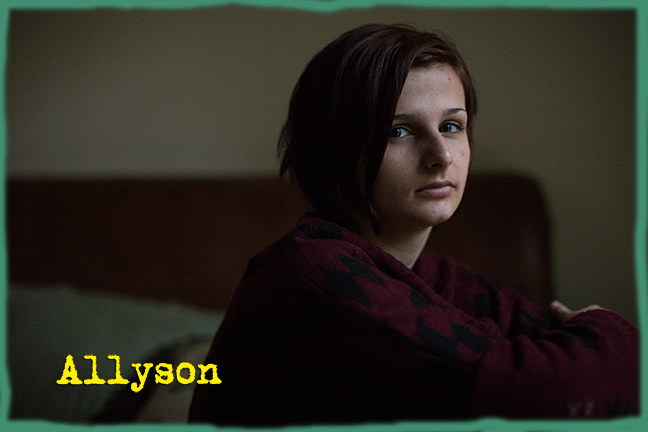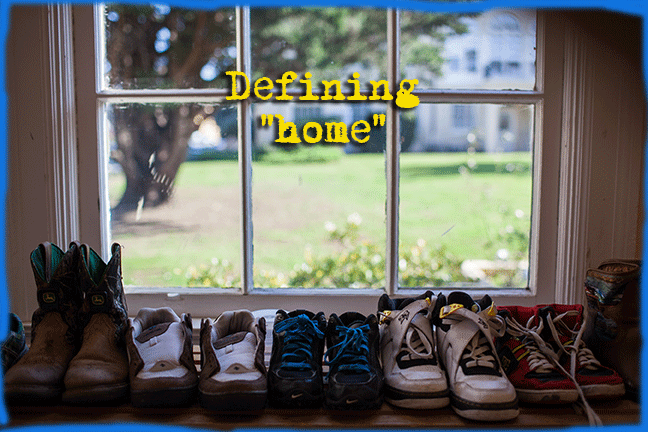COPS, GROUP HOMES & CRIMINALIZED KIDS
Is There Collateral Damage If Law Enforcement is Called When Foster Kids Act Out?
by Brian Rinker
This story was produced in collaboration with The Chronicle of Social Change.
Allyson Bendell wasn’t always the most well behaved girl, but that didn’t make her a criminal either.
In the world of group homes, however, where staff who are often undertrained and overwhelmed try to manage the severe behaviors that foster youth disproportionately exhibit, calling the police, for some, has become a go-to method for controlling kids. A new law that went into effect the first of the new year is trying to change all that by forestalling excessive calls to police and, in so doing, mitigating the stigmatizing effect that contact with law enforcement invariably has on the kids.
Bendell, 17, is one of those kids, who for years, was frequently on the receiving end of the kind of unnecessary police intervention that the new law hopes to eliminate. She wound up bouncing through group homes and foster families because her emotional and behavioral issues made her difficult for less trained staff to handle. She was defiant, prone to outbursts—screaming, yelling, cussing—and running away. She threw temper tantrums. A lot.
She spent most of her life in foster care, beginning when she was age 5. Bendell said her mother and father’s parental rights were terminated when she was 7. One of her parents was in prison, the other homeless.
“The anger came from being alone,” Bendell said. “I wanted someone to love me.”
In her 12 years in the system, she moved through more than 30 foster care placements, including a string of foster families, two group homes and many emergency shelters, temporary housing for foster youth in between placements.
While Bendell admitted that her behavior made life difficult for those trying to care for her, she said that none of her foster families called the police. It was only the group facilities that got the cops involved.
“I was trying to be heard and feeling like no one would really listen,” Bendell said. “I needed a one-on-one connection and a group is the worst situation for that.”
Joan Berry, who was Bendell’s Court Appointed Special Advocate, or CASA, agreed with the assessment.
“Ally has had really good experiences in foster care, but her temper tantrums made it difficult,” Berry said. “Ally is a child of the system and it is very hard to overcome that.”
At 13, she went to live in a San Joaquin County level-14 group home, run by Valley Oak Residential. Level-14 homes are meant to serve youth with serious emotional issues, a designation that Bendell said she did not fit. She said that most of the girls there were older and violent, and that the staff regularly called the police.
“The group home staff used the police to intimidate the girls to keep them in check,” Bendell said. If the kids acted out, fought each other, yelled, threw chairs at the wall, the police would come and each girl would have to sit on their bed as the cops lectured them. “The police were used as a ruling hand. They were used as control. They were used as a behavioral correction.”
Valley Oak Residential did not respond to requests for comment.
“Being in a group home with that much police involvement made it so much harder to be normal,” said Bendell, “It was worse than a correctional facility, more like a holding cell. There was no correction going on, you’re just being kept there.”
HOPING FOR NORMAL
Providing foster youth with the most normal, homelike experience possible-—while making sure that the experience is a safe one—-is what’s at the heart of the new law, AB 388, which means minimizing the presence of law enforcement in group homes, and curtailing extended stays in juvenile hall for foster kids who are detained because they have nowhere else to go.
“The purpose of [the law] is to prevent foster youth from being arrested and charged for misbehavior that wouldn’t happen to anyone other than a foster youth,” said Martha Matthews, an attorney for Public Counsel, a pro bono law firm that represents children. “The mere fact that someone is in foster care should not result in their being detained.”
With these goals in mind, AB 388, will trigger a state investigation once a year into any group home that calls the police “a greater than average number” of times. What “greater than average” actually means is still to be determined. That number will probably arise from the new data the law is requiring group homes to collect and release. From now on group homes will have to report every time one of its youth comes in contact with law enforcement, and provide a follow-up report within six months to the state Community Care Licensing Division, a division of Social Services charged with overseeing residential facilities, including group homes.
For foster youth who are detained at juvenile hall, the law requires immediate notification of child welfare services and an attorney for alternative placement.
The law also mandates the creation of a committee of stakeholders, including government agencies, foster youth, advocates and providers, its purpose to strategize and research programs and interventions in order to further minimize law enforcement contact in group homes.
Former Assemblyman Wesley Chesbro (D) introduced the law, which Public Counsel and the other co-sponsors had drafted. (Chesbro termed out in November.) In a fact sheet on the bill circulated in July, Mathews cited case examples including that of a bipolar teen who spent 36 days in juvenile hall for punching a hole in the wall of her group home.
“We didn’t have scientific data (on how many times group homes called the police) but we had the experience of a lot of advocates,” said Matthews who, prior to coming to Public Counsel worked for Children’s Law Center, which represents all 25,000 foster youth in Los Angeles County.
Matthews said she hopes the law makes it clear to group homes that they must find better and more therapeutic methods than involving police when youth in their care act out.
BUT IS THERE A DOWNSIDE TO THE LAW?
The California Alliance and Family Services, an association that represents more than 100 youth service providers including many group homes, worked with the authors of AB 388 last year as it made its way through the State Legislature. The alliance ended up neither endorsing nor opposing the law. The bill passed unanimously.
Yet some professionals in the field worry that the law will have unintended consequences, like preventing staff from calling the law enforcement at those times when police intervention is needed, for fear of triggering an investigation. Worse still, they say, is the concern that certain providers will be hesitant to take in the highest needs kids.
“I’m not sure the net affect of AB 388 will keep foster kids from being referred to the criminal justice system,” said Ken Berrick, CEO of Seneca, a nonprofit service provider for children with serious emotional issues, which also ran group homes until 2012. “I fear the net affect will be kids who are most at risk will have a harder time being placed.”
Despite his reservations, Berrick sees no problem with the intent of the bill. “Using law enforcement as a behavioral tool is fundamentally a bad idea.”
Matt Madaus, CEO of Edgewood, a 48-bed, level-14 residential facility in San Francisco also had misgivings. “It is unclear to me what [AB 388] will actually achieve,” he said in an email. “Group Homes are already required to report all police contacts related to a resident to Community Care Licensing.”
Community Care Licensing is the state agency in charge of overseeing residential facilities, including group homes.
The new law “will not add any value to the lives of the foster youth that Edgewood serves,” Madaus said. “We do not use the police as an intervention or to punish or scare a youth,” he added “As a policy and cultural practice, we do not contact the police for property destruction, verbal or physical aggression, or other manageable behaviors.”
According to documents obtained from the San Francisco Department of Emergency Management, there were 460 calls for police service to Edgewood during the last three years, averaging three calls a week. The reasons stated included attempted suicide, juvenile beyond control, assault or battery and mental detention. The majority of calls—204 in all—were for runaways.
OFFICERS & RUNNERS
Bendell was a runner. And running away is one of the most common types of group home incidents that end up involving cops. At her very first group home she got in an argument with staff and took off. Staff and police found her walking alone on the highway. She was 10 years old.
At Valley Oak Residential, where she landed when she was 13, she went AWOL several times. Sometimes she returned on her own. Other times, officers brought her back.
“It’s not like [the Valley Oak staff] are horrible people,” said Berry, Bendell’s CASA. “They just don’t have the resources. And these are tough kids.”
Bendell said she wasn’t violent and never threw a punch at Valley Oak. But her earlier group home located in northern California, she got into a scuffle with another 11-year girl.
“It went bad and I needed to escape,” said Bendell. She yelled and screamed and attempted to run away.
In that instance, to keep her from leaving and to calm her down, staff members sent her to what was known at the home as the “safety room,” a barren, cement room where problem children went to cool down, she said. It wasn’t a locked facility, so they couldn’t lock her in a room. But every time she tried to leave she said a staffer pushed her back inside.
When Bendell continued to be upset, the staff called the police and she was taken to juvenile hall, she said. The group home never came to get her; they didn’t want her back.
“I was an 11-year-old girl who threw a tantrum,” Bendell said. “I wasn’t acting acceptable, but I felt I was acting in a way they could have handled.”
She ended up at Valley Oak, which was the very last home to kick Bendell out. At 14, no other group home would take her in.
With nowhere to go, she asked a high school friend she had made during her time at Valley Oak if she could move in with the friend’s parents. They agreed, and everything changed. Bendell finally found a real home, with a family who didn’t called police if she lost her temper.
“They gave me a chance when no one else would,” said Bendell.
After years in a stable environment with adults who made clear that her wellbeing mattered to them, Bendell began to thrive. She was able to graduate from high school early, and got a job working in a restaurant. She is now living in transitional housing as she moves toward full independence.
She is also an advocate for foster youth with the California Youth Connection.
Bendell credits her turnaround to the support of her new family. “They showed me love and patience. They embraced my goals and dreams. They truly listened to me. They loved me,” Bendell said. “That’s why I am successful now. That’s my home.”
Photos by Max Whittaker of Prime Collective



